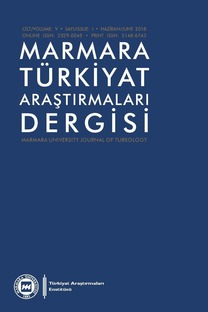Taclu Hanum: Çaldıran Savaşında Osmanlılar Tarafından Esir Alındı mı Alınmadı mı? / Tājlū Khānum: Was She Captured by the Ottomans at The Battle of Chāldırān, or Not? (Roger M. Savory)
23 Ağustos 1514 tarihinde Osmanlılar ile Safevîler arasında Çaldıran Ovası’nda dünya tarihinin en önemli savaşlarından biri cereyan etmiştir. Şiddetli bir şekilde gün boyu devam eden savaş, Safevî ordusununtam bir hezimetiyle sonuçlanmıştır. Her iki tarafın da ağır kayıplar verdiği savaşta, Safevî süvarilerinin önemli bir bölümü Osmanlı topçuları tarafından yok edilmiştir. Yenilgi kaçınılmaz hâle geldiğinde, Şâh İsmâʻîl, yaptığı ricat harekâtının ardından Tebrîz’e doğru firar etmiştir. Pek çok kaynakta bir miktar Safevî kadınının da, gömleklerinin üzerine örme zincirden bir zırh ve başlarına miğfer giyerek Osmanlılar’a karşı erkeklerle aynı safta savaştığı kaydedilmektedir. Savaştan sonra bazı Safevî kadınlarının cesedi savaş meydanında bulunmuş ve bu cesetler Osmanlılar tarafından defnedilmiştir. Bazı kaynaklarda Şâh İsmâʻîl’in hanımı Taclu Hanum’un da savaş meydanında bizzat Osmanlılar’a karşı savaştığı belirtilmiştir. Bazı Osmanlı tarihçileri, birkaç Safevî kadınının Osmanlılar tarafından Çaldıran’da esir alındığını kaydetmişlerdir. Bu makalede, Çaldıran Savaşı’nda Osmanlılar tarafından esir alındığı iddia edilen Taclu Hanum’un durumu incelenecektir.
Anahtar Kelimeler:
Taclu Hanum, Çaldıran Savaşı; Şâh İsmâ'îl; Yavuz Sultan Selîm; Osmanlı Devleti; Safevî Devleti
-
[On 23 August 1514 one of the more significant battles in world history was fought between the Ottomans and Safavids on the plain of Chāldirān. The battle raged for most of the day and resulted in the complete defeat of the Safavid forces. Both of the armies suffered heavy casualties, in particular the Safavid cavalry who were decimated by the Ottoman artillery. When it was clear that the day was lost, Shāh Ismāʻīl, with 300 horsemen, made a fighting retreat from the battlefield in the direction of Tabrīz. In a great many of the sources it is recorded that some Safavid women, wearing chain mail over their tunics with helmets on their heads, stood alongside the men and fought against the Ottomans. After the battle, the bodies of a number of Safavid women were found on the battlefield, and were buried by the Ottomans. In some sources it was recorded that Tājlū Khānum, the wife of Shāh Ismāʻīl, herself also fought against the Ottomans on the battlefield. According to some of the Ottoman historians, some Safavid women were taken prisoner by the Ottomans at Chāldirān. This article discusses the situation of Tājlū Khānum, who, it is claimed, was taken prisoner by the Ottomans in the Battle of Chāldirān
Keywords:
Tājlū Khānum, Battle of Chāldirān, Shāh Ismāʻīl, Salīm I Ottoman Empire, Safavids],
___
- [Abel, A.,] “Dār al-harb”, EI2, II, E. J. Brill, Leiden 1965, [s. 126].
- Angiolello, bkz. Discourse.
- Aubin, Jean, “L’Avenement des Safavides reconsidere: Etudes Safavides III”, Moyen Orient et Ocean Indien, V, (1988), [s. 1-130].
- Babinger, Franz, Mehmed the Conqueror and His Time, (Princeton University, Bollingen Series, no. XCVI), 1978.
- Caʻferî, Mîr Huseyn, Tâclû Hânum: Zen-i sitîhende-yi Çâldirân, Tebrîz 1353/1974.
- Cragg, Kenneth, The House of Islam, Belmont, California 1969.
- [Gündüz, Tufan, “Şah İsmail’in Eşi Taçlı Begüm”, Türk Kültürü ve Hacı Bektaş Velî Araştırma Dergisi, 51, (2009), s. 223-233].
- el-Huseynî, Hûrşâh b. Kubâd, Târîh-i îlçî-yi Nizâmşâh, British Library, Add. 23513.
- el-Kumî, Kādî Ahmed b. Şerefu’d-dîn el-Huseyn el-Huseynî, Hulâsatu’t-tevârîh, ed. İhsân İşrâkî, I-II, (Tahran Üniversitesi Yayınları, 1771/1-2), Tahran 1359-1363/1980-1984.
- Felsefî, Nasrullâh, Çend makâle-yi târîhî ve edebî, Tahran 1343/1964.
- Gibb, H. A. R. - Bowen, Harold, Islamic Society and the Law, I/1, Oxford University Press, 1950.
- Hakîmü’d-dîn İdrîs-i Bitlîsî, Selîm-nâme, British Library, Ms. Add. 24960; Ms. Or. 3248.
- Hinz, Walther, Irans Aufstieg zum Nationalstaat im fünfzehnten Jahrhundert, Berlin - Leipzig 1936.
- Kazvînî, Budâk Munşî, Cevâhiru’l-ahbâr, St. Petersburg Library, Ms. Dorn 288.
- Knolles, Richard, The General Historie of the Turkes from the first beginning of that Nation to the rising of the Ottoman Familie, together with the lives and conquets of the Ottoman Kings and Emperours etc., London 1603.
- Muir, Sir William, The Caliphate: Its Rise, Decline and Fall, Edinburgh 1924.
- [Müneccimbaşı, Sahâ’ifü’l-ahbâr, İstanbul 1285/1867-68].
- Pârsâdûst, Menûçehr, Şâh İsmâʻîl-i Evvel: Pâdişâhî-yi bâ âsârhâ-yi dîrpây der İrân ve İrânî, Tahran 1373/1996.
- Peirce, Leslie P., The Imperial Harem: Women and Sovereignty in the Ottoman Empire, Oxford University Press, 1993.
- Roemer, H. R., “The Safavid Period”, Cambridge History of Iran, VI, Cambridge University Press, 1986.
- Rûmlû, Hasan, Ahsenu’t-tevârîh, ed. C. N. Seddon, (Oriental Institute), Baroda 1931.
- Savory, Roger M., Studies on the History of Safavid Iran, Variorum Reprints, London 1987.
- [Schacht, J.,] “Amān”, EI2, I, E. J. Brill, Leiden 1960, [s. 429-430].
- Shaw, Standford J., History of the Ottoman Empire and Modern Turkey, vol. I, Empire of the Gazis: The Rise and Decline of the Empire 1280-1808, Cambridge University Press, 1976.
- [Tekleli (Nuriyeva), Minahanım - Aliyeva, Feride, “Taçlı Begüm’ün Hayatı Hakkında Yeni Olgular”, Akademik Tarih ve Düşünce Dergisi, I/4, (2014), s. 1-13].
- Uluçay, M. Çağatay, Osmanlı Sultanlarına Aşk Mektupları, İstanbul 1950.
- [Uzunçarşılı, İsmail Hakkı, “Şah İsmail’in Zevcesi Taclı Hanım’ın Mücevheratı”, Belleten, XXIII/92, (1959), s. 611-619].
- [Uzunçarşılı, İsmail Hakkı, Osmanlı Tarihi, II, Ankara 1983].
- Woods, John E., The Aqquyunlu: A Study in 15th/9th Century Turko-Iranian Politics, (Bibliotheca Islamica), Minneapolis - Chicago 1976.
- ISSN: 2148-6743
- Yayın Aralığı: Yılda 2 Sayı
- Başlangıç: 2014
- Yayıncı: Marmara Üniversitesi
